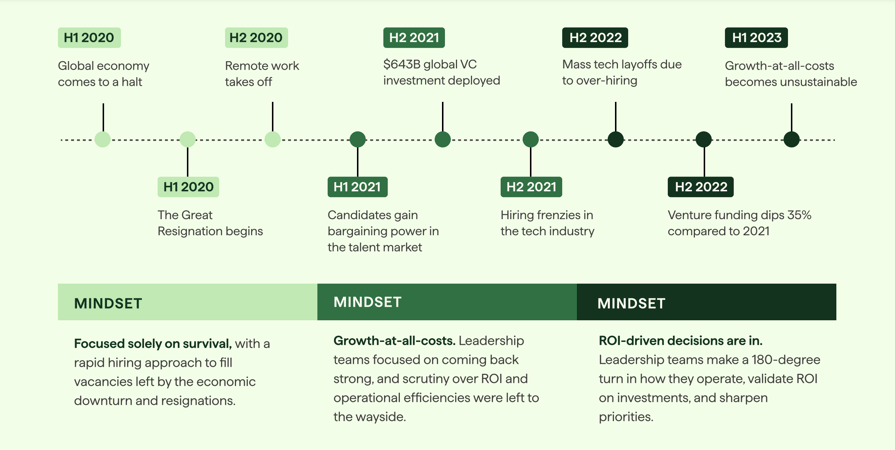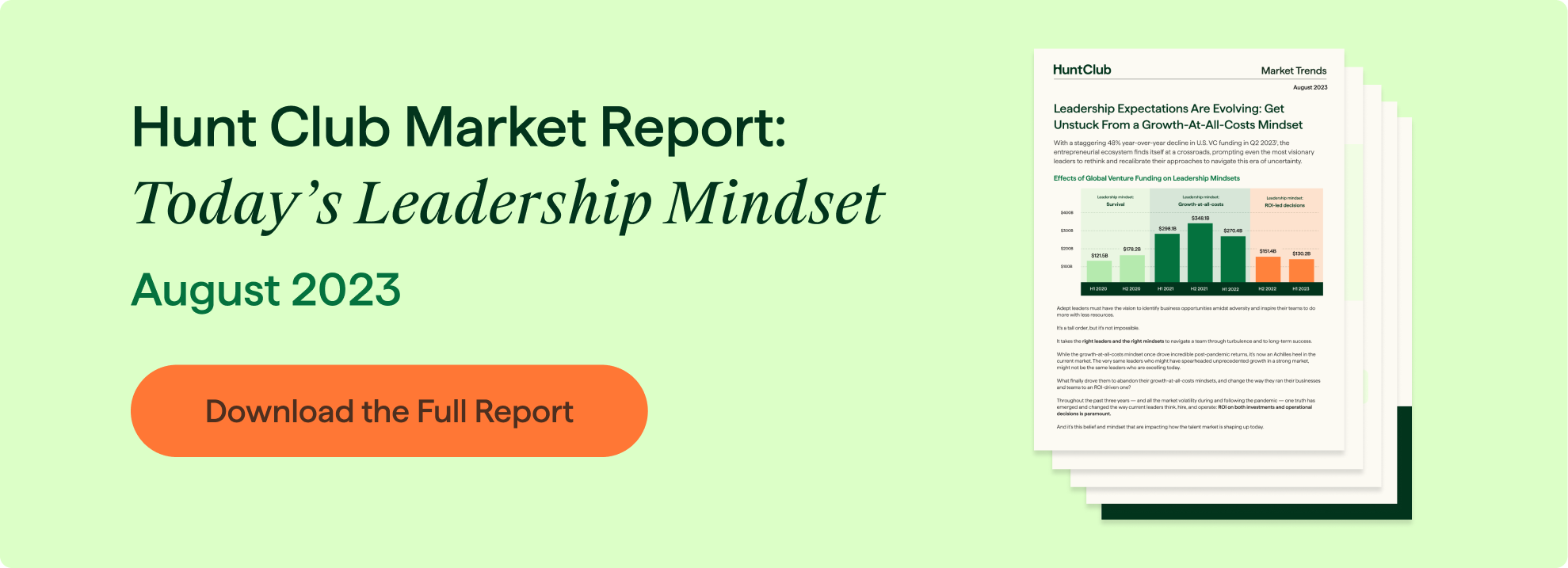With a staggering 48% year-over-year decline in U.S. VC funding in Q2 2023, the entrepreneurial ecosystem finds itself at a crossroads, prompting even the most visionary leaders to rethink and recalibrate their approaches to navigate this era of uncertainty.
While the growth-at-all-costs mindset once drove incredible post-pandemic returns, it’s now an Achilles heel in the current market. The very same leaders who might have spearheaded unprecedented growth in a strong market, might not be the same leaders who are excelling today.
What finally drove founders and leaders to abandon their growth-at-all-costs mindsets, and change the way they ran their businesses and teams to an ROI-driven one?
Throughout the past three years — with and amidst ongoing market volatility during and following the pandemic — one truth has emerged and changed the way current leaders think, hire, and operate: ROI on both investments and operational decisions is paramount.
And it’s this belief and mindset that are impacting how the talent market is shaping up today.
Change is hard. Changing gears 3 times in 3 years is even harder.

We’ve experienced unparalleled change and disruption in the last three years. The market pendulum has swung from one extreme to the other so quickly (and so often), that “leadership fatigue" has gripped many organizations as they made multiple 180-degree turns, adjusted their mindsets, and pivoted strategies in the fight for survival.
Recession, Resignation & Remote Work: H1 2020 – H2 2020
- Recession: The pandemic triggered significant job losses, escalated the unemployment rate to a peak of 13.0% in Q2 2020, and resulted in many exiting the workforce.
- The Great Resignation: Over 47 million Americans voluntarily left their jobs — an unprecedented workforce departure that highlighted wage and work-life balance disparities.
- Remote work: Remote work was here to stay even as businesses reopened. More than half (54%) of employees surveyed from around the world said they would consider leaving their job if they are not afforded some form of flexibility in where and when they work.
Leadership's mindset: Focused solely on survival, with a rapid hiring approach to fill vacancies left by the economic downturn and resignations.
Recovery & A Strong Comeback: H1 2021 – H2 2021
- Cheap capital: Growth came easily in 2021 as a record-shattering $643B of global venture investment was deployed into the market. Businesses collectively moved up and to the right, jumpstarting a hiring frenzy all in the name of growth.
- Top dollar for top talent: The Great Resignation left short-staffed and overworked teams in its wake. Companies vied for the same top talent which allowed candidates to negotiate for ~27% higher compensation. Because of how much capital was being deployed, companies were able to afford this premium.
- Digital acceleration: Remote work spurred rapid digitalization, and the demand for digital skills increased with it. Jobs in tech, data science, cybersecurity, digital marketing, and other related fields took off.
Leadership's mindset: Growth-at-all-costs. Leadership teams focused on coming back strong, and scrutiny over ROI and operational efficiencies were left to the wayside.
Reset & Rebalance: H2 2022 – H1 2023
- Dialing back: Venture funding dipped to $415.1B at the close of 2022, marking a significant 35% drop from 2021. The hiring frenzy slowed and high-profile tech layoffs soared as cheap capital exited the market.
- Rebalancing teams: Tech layoffs and AI automation dominated headlines. This had more to do with a rebalance of the tech sector, as the layoffs were largely a reaction to the over-hiring we saw in H1 2022.
- Investors step in: Growth-at-all-cost mindsets became unsustainable and expensive. Investors and boards looked to leadership teams to shift strategies again.
With the amount of strategy reversals, employee churn, and market shifts, leadership teams have come to realize that they must adopt a new mindset that will help them win:
Growth-at-all-costs is out. The ability to make pragmatic, ROI-driven decisions is in.
It’s precisely this mindset that's influencing everything from operations to key hires and org structures, and it'll be this mindset that endures market trends and volatility.
Lean Into the Curve: Building & Future-Proofing Leadership Teams
While we can’t always predict the future, there are some steps to take to fortify and safeguard your existing and incoming leadership teams against volatility.
1. Use a Recruiting ROI Framework As Part of Your Talent Efforts
To avoid seeing the high rate of layoffs we saw in the first half of 2022 as a result of over-hiring in 2021, organizations should aim to apply a strategic framework to all hiring and talent needs to ensure teams remain as effective and ROI-driven as possible.
Why You Need A Framework
- Topgrading Inc. states, “The estimated cost of a bad hire ranges from 5 to 27 times the amount of the person’s actual salary.
- A Brandon Hall Group survey states that organizations with a strong onboarding process improve new hire retention by 82% and productivity by over 70%.
- Companies that hire managers based on their management talent, such as the ability to create a culture of accountability and build trusting relationships saw a 48% increase in profitability.
2. Revitalize Your Leadership Interviews With Topgrading
Topgrading questions focus on the candidate's talent and innate ability, rather than their experience. Sample topgrading questions include:
- Describe the most influential experiences that shaped your values and personality.
- Give us an example of a heavy disappointment from your high school career.
- How did your first job shape you as a professional?
- Describe your decision-making process.
- What does accountability mean to you?
- Have any of your work mistakes changed how you view the world or what you value?

3. Invest In Emotional Intelligence (EQ)
Leaders who possess high emotional intelligence and keep their teams engaged and aligned will be the reasons why companies succeed in this environment. Those that continue to lead and manage by old-school tactics will continue to see higher attrition, lower employee engagement, and reduced productivity.
High EQ must be paired with high performance. It is not a one-or-the-other equation, and many organizations have gone too much in one direction or the other. Namely, focused solely on EQ or solely on performance metrics.
The balance lies somewhere in the middle, and when senior talent and leaders can strike this perfect balance, it helps them make well-informed choices and unlock ROI leadership.
What Is ROI Leadership?
The antithesis of the grow-at-all-costs mindset is an ROI mentality. When speaking with potential leadership candidates or to evaluate your current team, root your assessment in these three key qualities:
- The ability to identify opportunities: Can they identify opportunities for growth and improvement? Can they think pragmatically about investment decisions while both sweating the details and staying focused on the bigger picture?
- The ability to make informed decisions: Can they gather relevant information and make sound decisions based on that data? Do they consider the potential costs and benefits of each option?
- The ability to take action or adjust: Can they take decisive action to turn their vision into reality? Are they able to adjust plans as needed based on new information or changes in circumstances?
4. In For the Long Haul: Evaluating Leaders After Onboarding
The work doesn’t stop after onboarding a new leadership hire. Now's the time to double down on evaluating how they’re bringing enduring value to the organization.
An Employee Lifetime Value framework shifts focus from short-term gains new hires bring to the table to evaluating the long-term impact of your hiring choices. Here are four ways to increase ELTV:
- Shorten the ramp-up time it takes a new hire to become a fully contributing team member.
- Increase the employee’s ability to achieve higher performance levels and output.
- Create space for an employee to grow within the company, from promotions to lateral moves.
- Lengthen the time an employee stays with the company through strategies like building an inclusive workplace culture, providing professional development opportunities, and supporting a flexible work schedule.
The ROI Mindset: The Key To Winning In Any Market
In an era of constant market fluctuations and uncertainty, the key to sustained success lies in adopting prudent, ROI-driven mindsets. To truly thrive, it’s imperative to hire the right leaders who fully embody this outlook, and to construct teams that can lean into the curve.
If you're looking to find your next leader with this mindset, our Talent Advisors are here to help you.








